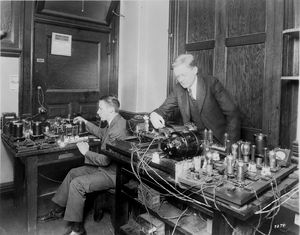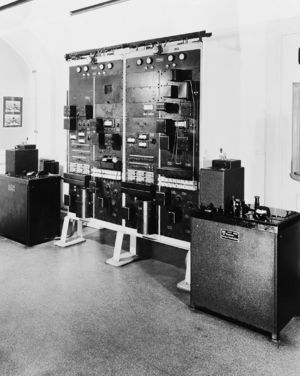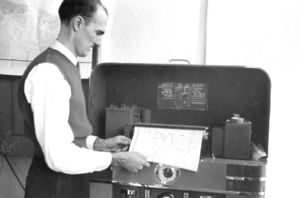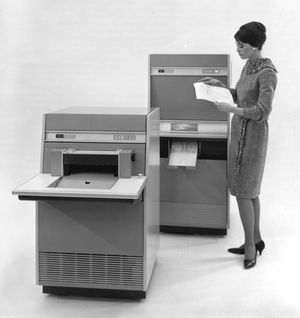Fax Machines
This article was initially written as part of the IEEE STARS program.
Citation
The concept of electrically transmitting an exact copy (from the Latin fac-simile, "make similar") has been credited to the Scottish inventor, Alexander Bain (1810-76) who received a patent in Great Britain and Ireland on 27 May 1843, then by the US Patent Office as US 5957 on 5 December 1848 that described his process of electronically copying and transmitting images between distant locales. The first commercial service operated in the 1860s but the first profitable service appeared only after World War I. The mid-1960s saw the first sustained efforts to produce fax machines for general business use. Fax became an essential communications tool in the 1980s, first in Japan, followed by the United States and the rest of the world. By 2000, however, e-mail and the Internet had rendered the fax machine obsolescent, though not obsolete.
Introduction
The basic concept of a facsimile, or fax, machine–a machine that electrically transmits an image–has not changed since 1843. The three main components remain the scanner-transmitter, the transmitting medium, and the receiver-recorder. Three broad, intertwined, technical trends help define the history of facsimile. First, the complexity of fax equipment vastly increased over time. Second, as machines became more sophisticated, they became "black boxes," their technical aspects increasingly hidden from view. Third, and ironically enough, they became easier to use while more sophisticated in capability. Beyond the black, or gray, or white box of the machine, there were changes in facsimile’s enabling and supporting technologies, the social environment, its competition, and the expectations and assumptions of its promoters and users.
The history of the fax machine reflects the changing nature of “high technology,” a phrase signifying a technology on the cutting edge of novelty and almost–or actually–practical. Facsimile’s history relies on technical and business advances in the telecommunications, electronics, and computer industries; without them, there would be no fax industry. Fax history is therefore a global tale, involving the competition and diffusion of ideas, research, and manufacturing from Europe to North America to Japan and back. These shifts reflected larger movements of technology, manufacturing, and capital, and thus changes in the relative capabilities and status of countries.
An integral part of fax’s evolution was competition—within the technology, and without. From Alexander Bain and Frederick Bakewell in the 1840s; Giovanni Caselli and Bernhard Meyer in the 1860s; Arthur Korn and Eduoard Belin in the 1910s; Wirephoto and Soundphoto in the 1930s; Times Facsimile Inc. and Radio Inventions Inc. after World War II; to Western Union and Xerox in the 1950s-60s, there was no area of the fax market, no niche too small, for players to struggle against each other for commercial acceptance. (Figure 1)
Until the 1950s, individuals were the key developers and rivals. Alexander Bain, a Scotsman who immigrated to London to pursue clockmaking opportunities, patented the first facsimile machine in 1843. Unlike his electrochemical paper, his machine never reached the market. Nor did Frederick Bakewell’s 1848 invention, which was displayed at the 1851 Crystal Palace exhibition in London. Some, like Thomas Edison or John V. L. Hogan, operated their own companies while others, like Austin Cooley or John Young, worked within larger corporate structures. While individuals remained critically important, after the 1950s the growing amount of technical expertise, financial resources, and marketing ability needed to create a commercially viable product meant corporations became the main players. The failure of numerous startups with good ideas but little else reinforces this point.
Optimism about fax’s potential resided in a procession of enthusiasts and advocates whose visions outran the technically and commercially possible until the 1980s. Facsimile document transmission was a “coming wonder” in the 1930s, a “Cinderella” in the 1940s, a “commercial infant” in the 1950s, and a “sleeping giant” in the 1960s. Time after time, manufacturers and potential customers proposed uses years or decades ahead of their successful implementation. The many proposed and attempted uses meant that fax’s consumers changed with the technology. In the 19th and early 20th centuries, telegraph and telephone companies actually bought or built the machines, then operated them. The ultimate customers were indirect users, who chose to buy newspapers with the most recent photographs. By the 1970s, however, the ultimate customer was increasingly the actual user, as fax machines migrated to desktops.
Commercial Challenges
If the idea of transmitting images was such a good idea, why did it take so long to succeed commercially? Certainly it was not for lack of trying, for over the decades scores of inventors and companies tried to develop and market fax machines. The overwhelming majority failed. Indeed, a theme running like a river through fax’s history is failure–of ideas, technologies, projects, and companies that never succeeded. Given that daunting history, what motivated individuals and firms to commit resources to create new markets and technology for facsimile?
Most important was the belief, “This time it will be different.” Promoters of a new product or service explained that previous failures occurred because the machines were too expensive, too slow, or in other ways lacking. Often the new versions did improve upon the old–but not significantly enough. One reason was that the criteria for success became stricter as expectations increased. What would have been spectacular in 1965 was obsolete in 1980. As historian Ruth Schwartz Cowan has observed, the rising capabilities of a technology usually increase expectations of what the technology should do. Faxing’s desired generic goals of easy operation, low cost, quality copy, and high speed changed remarkably little over time, but expectations always outpaced capabilities as prospective and actual users kept raising the standard of those goals.
Fax inventors and entrepreneurs also competed with established and new alternatives for transmitting information: the telegraph, telephone, letter, telex, express delivery, and finally email and the Internet. These served as benchmarks for users to decide whether to use facsimile. Faxing differed qualitatively from other forms of communication. Like the telephone, fax arrived instantaneously. Like regular mail and overnight delivery, fax delivered images as well as graphics. Like email, faxes arrived by computer. Unlike the telephone and television, fax provided a written record. No other form of communications combined these attributes of immediacy, imagery, and hard copy. The importance of these attributes changed greatly over time, however, affecting the attractiveness of fax systems for different users in different contexts.
For most of fax’s history, mail and telegraphy worked very well at far less cost and effort. Consequently, faxing, like many other technologies, first found success not as a general-purpose machine for many customers but in filling specific niches, primarily newspaper, weather and military uses, even as numerous attempts to find larger markets failed.
The commercial challenge was to create a product that could either compete with existing telegraphy or find a niche market sufficiently sheltered from competition to profit. Underlying that financial hurdle were technological challenges that included every aspect of faxing as well as more generic issues, such as providing power and constant speed for scanning and printing. Early inventors employed clockwork, which could be controlled by weights or pendulums, but achieving uniform motion proved very hard. Only in the 1870s did electric motors become sufficiently reliable and regular. Gearing was another perennial problem for electromechanical systems.
Technical Challenges
The basics of facsimile remained constant over the decades. The message had to be created, scanned, converted to electrical impulses, transmitted to the receiving machine, and then reconverted and reproduced. In the first decades, that meant an electrically conductive stylus scanned a message written with insulating ink on a metal foil. A telegraph line transmitted the signal to a receiver, which copied the message onto chemically treated paper. This simple explanation hides the myriad challenges that inventors had to recognize, understand, and solve.
Consequently, fax developers depended on craftsmen and mechanics to turn their ideas into reality. What held true in 1847 was equally true 100 years later; as the February 1947 Electronic Engineering noted, “Perhaps the most important factor in a really first class Picture Telegraphy system is the standard of mechanical design and workmanship which goes into the scanning and optical systems.” (p. 46)
Preparing a fax message took more effort and materials, such as metallic paper and special ink, than a telegram. The sender did not simply dash off a note and hand it to the telegraph clerk. To be scanned, the message had to physically contrast with its medium. Only by physically sensing the surface could a stylus scan the message accurately. (Figure 2)
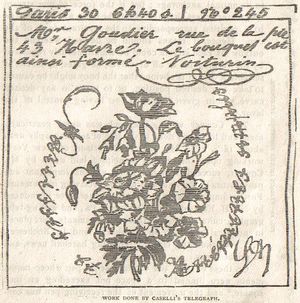
Transmitting faced major challenges of synchronization and the quality of wires. Line quality was often outside the developer’s control; synchronization was not but effective solutions were elusive. Both problems often resulted in resending illegible messages, adding to the cost and time of faxing.
Recording was the final bottleneck. A paper soaked in an electrochemical solution was the medium of choice because a current could mark the paper. Although electrochemical paper had problems of preparation and the short (a few days or weeks) life of a moistened material, it continued to dominate as a print medium. It could most easily transform the received signal into an image despite attempts to use pens, pencils, and other means of recording.
A functioning system was only the first step to success. Fax machines also had to prove fast, reliable, comparatively easy to maintain and operate, and financially feasible. The comparison was with other message technologies, and facsimile inventors spent the 19th century improving its capabilities while falling further behind their competition. It is striking how clearly fax developers understood the obstacles they faced, possibly because many experimenters had successful telegraph inventions to their credit and they understood telegraphy’s weaknesses. Inventors and ideas flowed easily between faxing and telegraphy. The prize of augmenting or replacing the latter, worldwide, system of instant communication continued to attract inventors like moths to a flame.
Birth of a Practical Technology, 1865-1910s
The French telegraph service initiated the world’s first operational fax service in 1865, using Abbé Giovanni Caselli’s Pantelegraph system to link Paris and Lyon until 1867, and then Bernhard Meyer’s Kopiertelegraphen in 1868-69. Meyer's fax system proved superior to Caselli’s as well as the telegraphs of William Cook and Samuel Morse. Unfortunately for Meyer, Morse was yesterday’s telegraphy. Improved equipment that transmitted faster and automatically, like the printing telegraph of David Hughes, proved more attractive than his Pantelegraph.
Photo-electric faxing, the technique used today, began in 1881 when English physicist Shelford Bidwell transmitted images electrically using a selenium cell, the forerunner of the photoelectric cell. Over two decades elapsed, however, before the first selenium system transmitted a picture for a newspaper. The lag was not for lack of effort, but practicality. Selenium was a difficult material to handle, proving sensitive to aging, changes in temperature, and other environmental shifts.
Dr. Arthur Korn at the University of Munich not only created the first practical selenium-based system but proved an excellent promoter, inspiring picture telegraphy networks over telephone wires. Korn began working on facsimile in 1901 and in 1904 transmitted his first long-distance photograph, in 42 minutes, between newspapers in Berlin and Nuremberg. In 1907 German, French, and English newspapers began publishing photographs transmitted in twelve minutes via his phototeleautograph. (Figure 3)

Early Applications, 1910s-1960s
In World War I, the German military experimented with faxing maps and photographs by landlines and faxing artillery targets from airplanes by radio, the first application of wireless fax. More important were war-spurred improvements in electronics that prompted a surge of research. (Figure 4)
By 1928 at least nineteen different systems were under development in Europe, the United States, and Japan, with four operating commercially. (Figure 5)
Three major forms of facsimile appeared: picture telegraphy (also called telephotography and wirephoto), direct telegram replacement, and message facsimile.
Although more technologically demanding, picture telegraphy appeared first because it provided a unique product: rapid transmission of photographs for newspapers willing to pay premium prices. The number of fax machines was actually not that great—approximately 100 in 1933—but their significance extended far beyond their numbers. In 1930, newspaper photographs and the occasional document crossed large expanses of the earth in minutes via telegraph, telephone, and radio circuits, finally matching the speed of the telegraphed word.
Replacing telegrams, the dream of early fax pioneers, became partially feasible with systems pioneered by Eduoard Belin in France and Western Union in the United States. More novel was the concept of message fax, transmitting documents between offices. Although promising a wider audience, this faced such formidable technical challenges and strong competition from telegraphy and mail that its implementation remained on the horizon. The other new business model involved an alliance with newspapers and radio stations to provide facsimile newspapers printed at home. (Figure 6)
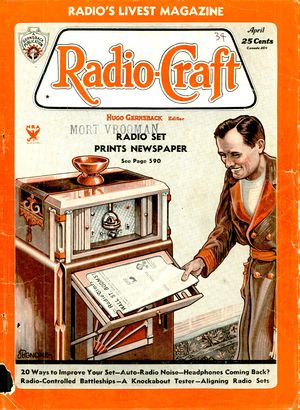
RCA, Finch Telecommunications, Hogan Laboratories, and newspapers in many American cities demonstrated the convenience, resolution, and condensed nature of faxed editions of the news before and after World War II. The costs and qualitative disadvantages of this system were joined by the versatility of television in putting it to rest by 1950, as millions of Americans bought boxy video receivers for news and entertainment. World War II saw a massive increase in the deployment of fax machines, primarily by the American military for transmitting weather maps and reconnaissance photographs. (Figure 7)
More publicly, the military faxed hundreds of photographs for newspapers back in the United States. While military interest had existed earlier, the demands and ready funding of wartime greatly increased the visibility of facsimile. Fax manufacturers had trouble, however, fulfilling contracts, thereby demonstrating the challenges of building the complex equipment. Military interest continued after the war; until the 1960s, the military was the main R&D patron and consumer of fax technology. At the same time, faxing entered many businesses in the 1950s via Western Union’s Desk-Fax, which sent telegrams to central offices. Over 40,000 machines, many formed into networks, sent millions of handwritten and typed messages. Ironically Western Union viewed Desk-Fax as a cost-cutting extension of the telegraph, and not as the forerunner of a new type of communication. (Figure 8)
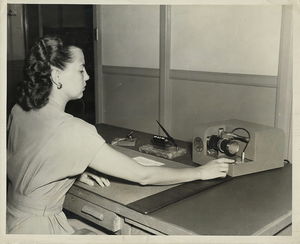
Faxing Goes Mainstream, 1970s-1980s
In the mid-1960s, American and Japanese firms brought facsimile out of its niche markets and began promoting it for general business purposes. Three factors explain the success of fax after so many false starts. New innovators, like Xerox and Graphic Science, changed the dynamics of the fax world, creating new excitement. (Figure 9)
Second, in both countries, deregulation of the telephone system (very gradually in the United States starting in 1968 and rapidly in Japan in 1972) eased access to the public telephone network by new devices and reduced the price of telephony, thus spurring the fax market. Third, the International Telecommunications Union (ITU) released the G1 (1968) and G2 (1976) standards, which reduced the scan and transmission time to six and three minutes respectively. Because fax machines had to be compatible to communicate with each other, agreement on standards was essential to the diffusion of facsimile. Forging and enforcing such agreements represented some of the most contentious challenges in the technology’s evolution. The first two generations of analog fax machines in the 1960s-70s still suffered from incompatibility among competing machines, despite creation of the ITU standards. Not until the approval of the ITU G3 standard in 1980 did manufacturers offer truly compatible equipment that could, in addition, scan and transmit a page in one minute. The result, which appeared first in Japan, was an explosion in fax sales. That country’s ideographic language provided the demand, and manufacturing expertise in consumer electronics provided the supply. (Figure 10)

In the United States, the number of fax machines grew from 25,000 in 1970 to 250,000 in 1980, but then exploded from 500,000 machines installed in 1985 to 5 million in 1990–nearly all made in Japan. This rapid growth of increasingly inexpensive machines turned faxing into the essential technology of an evolving global telecommunications network. Thoughtful design engineers in Japan blended several different technologies into a small, cheaper, faster, and more versatile machine that needed minimal training to operate. Machines now scanned and recorded digitally in less than fifteen seconds, encouraged by the G3 and G4 (1985) standards for digital compression; only transmission remained analog. Powerful data compression algorithms and microprocessors reduced transmission to less than a minute per page. New illumination and sensors accompanied the switch to digital scanning. Instead of photocells receiving the bright light reflected from the image, the light from low-power helium-neon lasers or light-emitting diodes (LEDs) reflected from a small segment of paper onto a long bar of solid-state photodiodes or charge-coupled devices (CCDs). For recording, an array of 1,728 film resistors, one per pixel, selectively warmed heat-sensitive paper. Thermal recording sharply cut the cost of fax machines, making them even more affordable.
No less important were the economic and social changes resulting from the liberalization of telephone networks in the United States and Japan, the growing internationalization of business, and the "just-in-time" mentality promoted by Federal Express, whose proprietary ZapMail facsimile service lost over $300 million in 1984-6. Coupled with the mounting costs and decreasing quality of traditional methods of communication, such as postal services, faxing appeared increasingly advantageous.
Fax’s Social Effects
In the mid-1980s, economics and technology finally caught up with the vision. The ease of experimentation and use, combined with its low cost and near universal adoption, made facsimile a democratic technology, accessible to all. Innovation in use proved even more intriguing and important as innovation in technology. During the student protests in China in 1989, for example, Chinese expatriates evaded the government’s censorship policies by faxing news of and responses to the protests back to readers in their home country.
The rapid acceptance and diffusion of fax equipment into the business community strengthened the globalization of the world economy by vastly easing the transfer of information worldwide. Most importantly, the fax machine circumvented time zones and eased the actual conduct of business. Faxing lunch orders to a deli sounds trivial, yet it embodied the virtues of fast, error-free transmission of information with a record for both parties, which just as useful when ordering agricultural equipment across the Pacific Ocean.
Facsimile strengthened the advantages of the written over the spoken word. Many people read and write English, the international language of commerce, better than they speak it. Faxing allowed written communications instead of telephony. The fax machine also allowed writers of ideograph-based alphabets to exchange information instantly, a major reason for the technology’s success in Japan.
Like any technology, the fax presented problems as well as opportunities. Questions about the legality, authenticity, and security of the transmitted message challenged users. More visibly, faxing’s easy operation quickly turned into a torrent of information, often unwanted or unnecessary, and all paid for by the recipient. In a variation of Gresham's law, bad data crowded out good, as junk faxes presaged the bane of e-mail: spam.
When Fax and Computers Converged
Even as stand-alone machines metastasized, a new wave of computer-based faxing emerged in the late 1980s and early 1990s that vastly extended the capabilities and value of fax. The merger of fax with computers was not accomplished easily and users found computer-based fax far more difficult and frustrating than stand-alone faxing, emblematic of changes in all technologies undergoing computerization. Consequently, although the first computer fax board appeared in 1986, computer-based faxing did not grow substantially until the early 1990s.
Four trends dominated this period. Prices dropped, products became easier to use and integrated into computers, and capabilities increased greatly in a competitive environment that drove firms to innovate continually. In less than a decade, computer-based faxing evolved from an interesting technical demonstration to an essential corporate tool. One of the most powerful and unexpected extensions of facsimile in the 1990s was fax-on-demand. More accurately described as automated faxed information-on-demand, this service merged faxing with computer databases and interactive voice technology to provide unprecedented and rapid access to information.
In the mid-1990s, the promise of faxing over the Internet (FoIP) attracted small businesses, mainly startups, which introduced new hardware, software, and services. In a demonstration of how international Internet development had become, several Israeli firms played important pioneering roles. By the new millennium, the FoIP market imploded, victim of the new Internet business model of free services, reduced long-distance telephone charges, and the dot-com collapse. The market continued, but in drastically altered form as FoIP providers emphasized services such as storage and enhanced recordkeeping, instead of reduced long-distance charges.
The Decline of Fax and Rise of Email
Within another five years, faxing had been eclipsed. It became its own worst enemy, laying the groundwork for email and the web. People became accustomed to exchanging messages easily in minutes, compressing the communications cycle from days or weeks. Computer-based faxing trained people to communicate from a computer and expect a quick reply. Fax-on-demand taught people to obtain information instantly and companies to provide it.
Email’s triumph stood on four foundations. Foremost was the 1982 creation of the Simplified Mail Transport Protocol (SMTP), which extended compatibility throughout incompatible networks. Second, the 1992 establishment of the Multimedia Internet Mail Extension (MIME) greatly encouraged email’s acceptance as a business tool. MIME enabled email to convey files of different types, content, and format from computer to computer, negating one of fax’s biggest advantages, binary file transfer. Together with Adobe’s development of the Portable Document Format and its decision to offer the reader free, emails could finally transmit documents effectively. This removed one of faxing’s major advantages.
Third, the changing office environment greatly benefited email. From 1991 to 2004, the number of PCs worldwide grew from 130 million to 775 million. Many of these machines were connected through modems and networks, and the number of email accounts exploded in the late 1990s, reaching an order of magnitude greater than fax machines. Email also benefited from a generation of users trained in Microsoft Word and other software, who now found it easy to operate email systems based on the GUI (graphical user interface) principles of Apple and Windows. Improvements in scanners enabled easier conversion of written documents into electronic form, allowing their manipulation and storage by computer while eliminating the need to send a document by a stand-alone fax machine.
Fourth, the World Wide Web made fax-on-demand obsolete. The search engine proved an overwhelming advantage in the quest for instant information. Fax’s advantages receded as email became increasingly easy to use and more common, thus benefiting from positive network externalities. Sales of stand-alone fax machines peaked in 1997 in the United States and 2000 in Japan. Unlike telex, which declined sharply after the fax boom of the 1980s, faxing declined slowly. For email, the critical point occurred when it became easier to use and less expensive than faxing, an accomplishment that took far longer than its advocates expected. Perhaps the best indicator of this transition was in the 2000s, when criminals switched their trolling for fraud or scam victims from fax to email.
Timeline
- 1843, First patent received by Alexander Bain in Great Britain (No. 9745)
- 1863, First commercial operating system begun by Abbé Giovanni Caselli in France
- 1904, First transmission by telephone sent by Arthur Korn in Germany
- 1925, First commercial wirephoto system by AT&T
- 1928, First Japanese fax system initiated by NEC’s Yasujiro Niwa and Masatsugu Kobayashi
- 1935, Associated Press begins AP Wirephoto service
- 1964, Xerox introduces Long Distance Xerography (LDX)
- 1966, Xerox introduces Magnafax Telecopier
- 1977, Japanese approve READ standard
- 1980, CCITT approves Group 3 standard
- 1985, First personal computer (PC) fax board introduced by GammaLink
- 1997, Fax machine sales peak in United States
- 2000, Fax machine sales peak in Japan
Bibliography
References of Historical Significance
Bain, Alexander. 1843. British patent no. 9745, granted 27 November 1843.
Callahan, John North, and Alfred Goldsmith, eds. 1938. Radio Facsimile: An Assemblage of Papers from Engineers of the RCA Laboratories relating to the Radio Transmission and Recorded Reception of Permanent Images, Volume 1. New York: RCA Institutes Technical Press
Jones, Charles R.. 1949. Facsimile. New York: Rinehart Books
Korn, Arthur, and Bruno Glatzel. 1911. Handbuch der Phototelegraphie und Telautographie. Leipzig: Otto Nemnich Verlag
Ministry of Posts and Telecommunications Fax Survey Research Group (Fakushimiri choosa kenkyuu kai). 1980. Facsimile. Its present state and future (Fakushimiru. Sono genjyoo to tenbaa). Tokyo: Ministry of Posts and Telecommunications
Hiromasa Sasaki, Matahira Kotani, and Takeo Tsumura. 1981. "Sharp Facsimile HAYAX FO1000 (Medium Speed G2 Machine), FO 2000 Series (High Speed G3 Machine)". Sharp Technical Journal 20 (March 1981), p. 125-32
References for Further Reading
Coopersmith, Jonathan. February 1993. “Facsimile's False Starts,”. IEEE Spectrum, p. 46-9
Coopersmith, Jonathan. July 2010. “Creating Fax Standards: Technology Red in Tooth and Claw?”. Kagakugijutsushi. The Japanese Journal for the History of Science and Technology 11, p. 37-66
McConnell, Kenneth R., Dennis Bodson, and Stephen Urban. 1999. FAX: Facsimile Technology and Systems, 3rd ed.. Boston: Artech House
Remsen, Marius. December 2004. Fax History. www.hffax.de/history/index.html
Wakabayashi, Kaoru. 2009. “Research and Events that Permitted Facsimile Use to Explode in Japan”. GLOBECOM Workshops (IEEE), p.1-6
About the Author
Jonathan Coopersmith is an Associate Professor of History at Texas A&M University, where he teaches the history of technology and modern European history. A former member of the IEEE History Committee, he is the author of numerous articles and a monograph, The Electrification of Russia, 1880-1926 (1992). Coopersmith’s Faxed: The Rise and Fall of the Fax Machine will be published by The Johns Hopkins University Press in January 2015.

